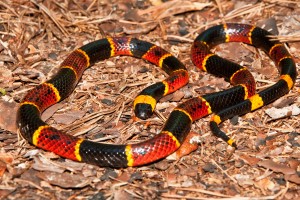 Twenty three snake species live in the Everglades. Of these 23, only four are venomous. Many people have a fear of snakes, and with several being poisonous, it makes sense why people prefer to stay away from these slithering creatures. However, these reptiles are an important part of the ecosystem of the Everglades. They control and prey on the number of rodents, invertebrates and other snakes. These snakes are also a food source for birds and alligators.
Twenty three snake species live in the Everglades. Of these 23, only four are venomous. Many people have a fear of snakes, and with several being poisonous, it makes sense why people prefer to stay away from these slithering creatures. However, these reptiles are an important part of the ecosystem of the Everglades. They control and prey on the number of rodents, invertebrates and other snakes. These snakes are also a food source for birds and alligators.
Types of Poisonous Snakes
The four venomous species of snacks found within the Everglades are: The Eastern coral snake, the Florida cottonmouth, the dusky pigmy rattlesnake, and the eastern diamondback rattlesnake.
Eastern Coral Snake – This snake is beautiful in color with red, yellow, and black bands running down its body. It prefers a wooded habitat and is considered to be very elusive in nature, since it spends a lot of time under ground or beneath foliage. Coral snakes are not confrontational and account for less than one percent of all bites that occur in North America every year; however, their bite is the most venomous of all the snakes on the continent. Its bite isn’t overly painful, but can cause death within a few hours.
Florida Cottonmouth – This snake is common and is also known as the “water moccasin.” It is a type of pit viper, and is the only semiaquatic viper species in the world. In the Everglades, this snake can be found around shallow waters like streams and marshes; they are strong swimmers. The cottonmouth is usually all black, brown, tan or olive; it also has a very thick body and can be up to six feet long. Its bite is painful and can lead to death.
Dusky Pigmy Rattlesnake—The dusky pigmy rattlesnake is a small snake (between two to three feet) that can be found in both wet and dry areas. Its coloring is gray with black/brown dorsal spots across its back with white flecks on the stomach. This snake is known to be aggressive and quick to bite with no warning. Since its fangs are small, it only releases a small amount of venom with a bite. Its bite is rarely fatal, but can post to be a greater risk to a child or pet.
Eastern Diamondback Rattlesnake – This snake is the biggest of the venomous snake in both mass and length; it has been known to grow up to eight feet. This snake is a great swimmer, often found by water; it is known to live underground sometimes. The diamondback rattlesnake has dark diamonds across its body, each separated by a whiteish color. Although extremely venomous, diamondbacks are not aggressive and try to warn a potential threat by rattling their tails.
How to Spot /Handle a Poisonous Snake
It’s not always easy to spot a poisonous snake because they can look similar to many non-venomous snakes. However, there are some general guidelines of differentiating a venomous snake from a non-venomous one.
- Most snakes with a triangular head are venomous.
- Snakes with length-wise stripes are non-venomous.
You also want to do your best to avoid interaction with one of these. Do not approach or touch the snake if you’re unsure of what species the snake is. If you want snakes to stay away from you, it’s a good idea to make a lot of noise while walking, so the snakes are aware you’re around. It’s best to keep your hands out of potential snake hiding spots (logs, brush, leaves, rock piles), as well. Also, keep on the trails; you’re less likely to run into a snake on a cleared path.
Sail by the Snakes
Snakes, although not the friendliest creatures, can still be quite the sight to see. But, you may not want to run into them, especially the venomous kind. An airboat tour is a great way to stay safe in the Everglades without running the risk of encountering a snake. The ride will also give you chance to see the habitat of these snakes. To check out the beautiful ecosystem that the snakes contribute to, book an airboat ride with Captain Mitch through the Everglades today!






